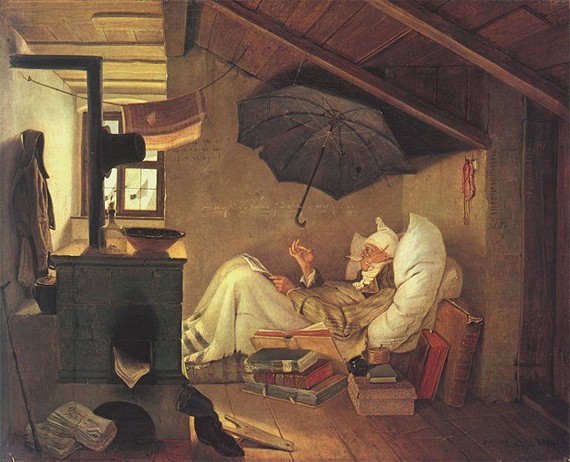Why the Starving Artist No Longer Exists

Every artist knows that the path to success is largely rocky and unpaved; filled with obstacles and challenges along the way. If you are a struggling artist, you may have felt abandoned by your family and friends occasionally. You might have been discouraged by others who called you foolish or immature. You might have been told to grow up and get a real job. But your creative soul knows there’s more to just getting a safe job and being just like everybody else.
Let’s admit it. Being an ‘artist’ is not the most practical career choice to make. It’s highly unpredictable, and you need a certain degree of luck to be able to break through. Choosing to be an artist seems like voluntary poverty. And in these hard economic times we are facing today,being an ‘artists’ seems all the more impractical, if not a stupid career path to take.
It is in this world of consumerism where people are taught to go corporate and look down upon artists and creative souls. We are all aware of the ‘starving artist’ archetype. That’s how society sees anyone who is ‘unconventionally creative’. You’re doomed to become starving artists unless you give up your artistic aspirations.

The Poor Poet by Carl Spitzweg (Image by Wiki)
Where did the ‘Starving Artist’ Stereotype come from?
The ‘Starving Artist’ evokes a romantic and mysterious feeling around it. The image evokes stories of the past; of artists, sculptors, musicians and actors who chose to live a life of poverty to pursue their dreams of success. It particularly evokes memories during the 18th Romanticism period. You can imagine young, enthusiastic men from the countryside dreaming to be artists who moved to the city and find themselves living the Bohemian lifestyle.
Even our greatest artists in history did not escape the fate of the Starving Artist. The Bohemian lifestyle—or unconventional living in the company of people with similar interests for artistic pursuits—is a common lifestyle chosen by artists then and today. Most did not see fame and fortune during their lifetime, only to have their works become worth millions of dollars after they passed away. One example is the great Vincent Van Gogh. Now, he is considered to be a true genius in art. Van Gogh’s works are worth a fortune now but during his lifetime, Van Gogh only sold one single painting–to his own brother.

Vincent Van Gogh's 'Starry Starry Night' is estimated to be worth more than US $100 million (although it is not for sale)
These legendary artists must have had found their fate funny when they died–all the sacrifices they made were never reaped and enjoyed. They can only look down from the afterlife and see how they’re valued and revered now. But if you think about it, maybe it wasn’t because the great artists weren’t given the chance to succeed. Or it wasn’t because these geniuses were just jinxed. In fact, most of the great artists of our history have poor financial sense. They prefer to squander their money with booze, drugs and women. Some were even economically foolish people with no plan or direction in life.
The Starving Artist vs. the Sell out
Because of how literature and popular media portrayed artists, the artists themselves were made to believe that they should lead a life of poverty. They hold on to this notion that art made from the impoverished article is superior from that of a well-off artist. But I beg to differ.

Image by Chicagoist
First of all, the ‘Path of the Starving Artist’ leads artists to a path that isn’t helpful, to themselves and to their careers. Poverty doesn’t always equate to better art. Knowing yourself and mastering your technique leads to better art; and poverty is only a distraction. Yes, the Starving Artist is a Myth! There are already plenty of artists that lived comfortably because of their art. Rembrandt was very successful in his time. So was Charles Dickens and Andy Warhol. Of course it’s more tempting to romanticize stories of failure, like the stories of Van Gogh and Mozart.
But on the other side of the spectrum, one can be in danger of becoming a ‘sellout’. Most artists dread becoming a sellout more than being a starving artist. Being a sell out is a term used within the artist group only; labeling those who are believed to have sold their artistic beliefs and aesthetics to have outward success.
But artists must not feel guilty to make a fortune from their art. You are not selling out because you’re making money–artists still need to eat, after all.
Job and Business Opportunities for Artists
Today, choosing the creative career path doesn’t mean you’re doomed to a life of poverty. Despite the recession, you can still find tons of jobs in the industry. It is time to debunk the ‘starving artist’ myth and believe that you can earn a decent income over a job or business that you will love.
Here are just a few fine arts-related jobs that you might want to consider:
- Graphic and Web Design – These artists create most of their art in front of the computer, doing layout, color manipulation, post-processing and design to meet the client’s needs. Graphic and web designers will mostly create logos, website layouts, animation, online and magazine ads, etc. You can make a starting income of around US $40,000 a year. While you don’t really need formal education to be a successful web and graphic designer, having a bachelor’s degree in design can be a great advantage.
- Video Game Design – Video game design is undoubtedly one of the best jobs in the world. Depending on your department, you get to develop the characters, story, gameplay and even music. One can earn as much as US $100,000 by doing something as cool as video game design. Most companies look for applicants with a degree in animation and video game design.
Image by How Stuff Works
- Copywriting - If you’re good with writing but still haven’t finished your own novel masterpiece, you can get by through copywriting. Creative writing is big, as companies are constantly looking for writers to write content that’s interesting and concise. You can earn around US $60,000 to US $90,000 in copywriting. Having a degree in liberal arts, communications and journalism will greatly help with this endeavor.
These are just a few of the career paths a creative-minded individual can consider. Of course, you can go freelance and not have to be associated with a particular design company. Better yet, you can be your own boss and start your own business. People innately love art; and they are always willing to pay for anything new and beautiful. The belief that art and business don’t mix comes from the same idiot that created the starving artist myth.
- Login om te reageren














